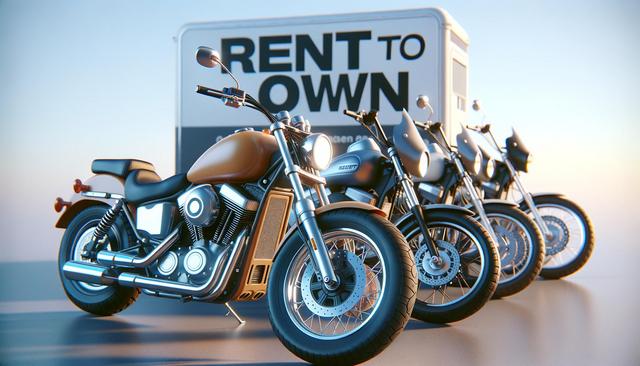Understanding the Rent to Own Concept
The rent to own motorcycle model offers a flexible path to ownership for riders who may not be ready or able to purchase a bike outright. This approach allows individuals to rent a motorcycle for a specific period with the option to buy it at the end of the agreement. It combines the benefits of leasing with the potential payoff of ownership, which can be especially helpful for those looking to build credit or gradually commit to a significant investment. Unlike traditional financing, rent to own agreements often have fewer credit requirements, making them more accessible to a broader range of consumers.
In this arrangement, monthly payments are made toward the cost of the motorcycle. A portion of each payment typically goes toward the eventual purchase price. At the end of the contract, the rider can choose to complete the purchase or return the bike, depending on the terms. This model is particularly popular in the used motorcycle market, where it offers an affordable way to test out ownership before fully investing.
Benefits of Rent to Own Motorcycles
There are several reasons why riders consider rent to own as a practical alternative to traditional purchase methods. This model provides a chance to experience long-term use of a motorcycle without the immediate financial burden of a full purchase. Some key benefits include:
- Lower initial costs compared to outright purchases
- Flexible payment structures
- Opportunity to try out the motorcycle over time
- Potential to build or improve credit
Moreover, the rent to own approach can be ideal for those uncertain about their long-term riding needs. It provides the opportunity to use a rental motorcycle while gradually moving toward ownership. This is particularly useful when considering a used motorcycle, where the rider might want to assess the condition and performance before fully committing.
Key Considerations Before Signing a Rent to Own Agreement
Before entering into a rent to own motorcycle agreement, it’s important to understand the specific terms and obligations. Each agreement can vary significantly, so potential buyers should review the contract carefully. Factors to consider include:
- Total cost of the agreement compared to market value
- Length of the rental term
- Amount applied toward purchase with each payment
- Maintenance responsibilities during the rental term
- Penalties for early termination or missed payments
Understanding these elements ensures that the rider makes an informed decision. It’s also important to assess the condition of the rental motorcycle before committing to a long-term plan, especially when dealing with used motorcycle options. A thorough inspection and a test ride can prevent future complications.
Finding Rent to Own Motorcycle Opportunities
Locating rent to own motorcycle options requires some research. Many local dealerships and independent sellers offer this type of arrangement, often marketing them as a budget-friendly alternative to standard financing. Online listings, classified ads, and dealer websites are useful starting points. Some dealerships may even specialize in rent to own plans, offering a wider range of motorcycles with flexible terms.
When evaluating offers, it’s crucial to compare different rental motorcycle agreements. Look at the total cost, the condition of the motorcycle, and the seller’s reputation. Used motorcycles are commonly included in rent to own deals, so ensuring the bike has a clean title and maintenance history is essential. Asking the following questions can help identify a reliable option:
- Is the motorcycle covered by any warranty during the rental period?
- What happens if repairs are needed during the agreement?
- Is there a down payment required?
- What are the final purchase terms and conditions?
By doing due diligence, riders can secure a rent to own deal that aligns with their budget and riding goals.
Maintaining the Motorcycle During the Rent to Own Period
Proper maintenance is a critical part of the rent to own process. While the bike may not be fully owned yet, taking care of it during the term ensures a smoother transition to ownership. Most agreements specify who is responsible for maintenance and repairs. In many cases, the renter is expected to maintain the bike to preserve its value.
Routine upkeep not only keeps the motorcycle in optimal condition but also helps avoid penalties or additional costs later. Key maintenance tasks include:
- Regular oil changes and fluid checks
- Tire inspections and replacements as needed
- Brake pad checks and replacements
- Chain lubrication and adjustments
- Keeping records of all service and repairs
This is especially important when dealing with a used motorcycle, as older bikes may require more attention. By staying on top of maintenance and documenting all work done, riders position themselves for a smoother final purchase and may even improve the resale value, if they choose to sell the bike later.
Conclusion: Is Rent to Own Right for You?
For many riders, rent to own motorcycles provide a flexible and accessible path to ownership. Whether you’re exploring a rental motorcycle to see if riding suits your lifestyle or considering a used motorcycle as a long-term option, this model offers a way to transition from renter to owner over time. However, it’s essential to fully understand the agreement, maintain the motorcycle properly, and compare options before committing.
By carefully evaluating the terms and aligning them with your financial situation and riding goals, rent to own can be a practical solution. It bridges the gap between short-term rental and full ownership, making motorcycle access more attainable for a wider audience.




Leave a Reply